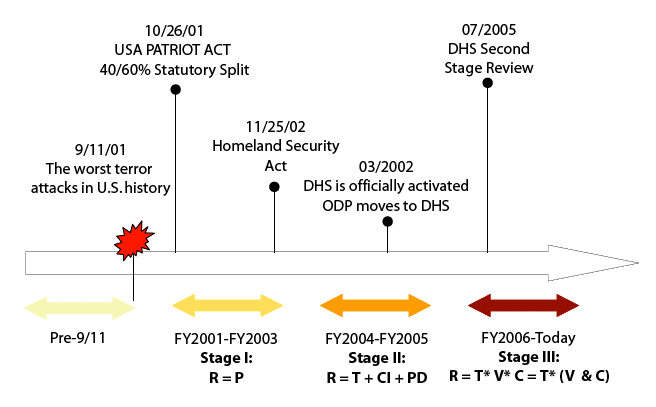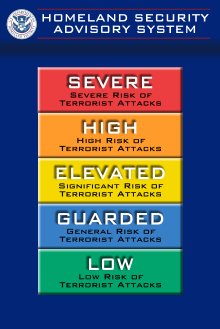 |
| NPHS 1510: Federal and International Framework |
| Emergency Problem Solving, Decision-Making and Risk |
|
| |
| Risk |
| |
As we have seen, people are not necessarily good at assessing risk and incorporating it into emergency decision making.
This section will provide a general view of risk. The following sections will address risk from a personal view and an infrastructure perspective. |
| |
| Definitions |
Risk: The estimated impact that a hazard event would have on people,
services, facilities, and structures in a community, or the likelihood of a
hazard event resulting in an adverse condition that causes injury or damage.
Risk is often expressed in relative terms such as a high, moderate, or low
likelihood of damage being sustained above a particular threshold as a result
of a specific type of hazard event. Risk also can be expressed in terms of
potential monetary losses associated with the intensity of the hazard event.
Vulnerability: How exposed or susceptible to damage an asset is. Vulnerability depends on an assetís construction, its contents, and the economic value
of its functions. Like indirect damages, the vulnerability of one element of
a community is often related to the vulnerability of another. For example,
many businesses depend on uninterrupted electrical power; if an electrical
substation is flooded, not only will the substation itself be affected, but a
number of businesses as well. Indirect effects can often be much more
widespread and damaging than direct ones.
Source: FEMA Risk Management Series (RMS). |
|
| |
| Definitions |
Hazard: Something that is potentially dangerous or harmful, often the root cause of an unwanted outcome.
Threat: An indication of possible violence, harm, or danger.
Source:
National Response Framework Resource Center |
|
| |
| Our concept of risk has evolved over time. It has been shaped by legislation and presidential directives. For a very good review of this process, see the Congressional Research Service Report cited in Resources below. The following diagram from that report summarizes the risk evolution. |
 |
| The early conceptualization of risk equated it with population. This was largely due to the common view that terrorists acts were largely aimed at influencing the behavior and perceptions of their human targets. |
| |
| R = P |
| |
|
| |
| The Homeland Security Act of 2002 created a new perspective on risk. Critical infrastructure was recognized as an important target of terrorists. Risk was then assessed as the sum of
threat (T), critical infrastructure (CI), and population density (PD). |
| The early conceptualization of risk equated it with population. |
| |
| R = T + CI + PD |
| |
| Definition |
Terrorism: any activity that involves an act dangerous to human life or potentially destructive of critical infrastructure or key resources; is a violation of the criminal laws of the United States or of any State or other subdivision of the United States in which it occurs; and is intended to intimidate or coerce the civilian population or influence or affect the conduct of a government by mass destruction, assassination, or kidnapping.
Source: Section 2 (15), Homeland Security Act of 2002, P.L. 107-296, 116 Stat. 2135 (2002). |
|
| |
| Definition |
Critical Infrastructure: Systems, assets, and networks, whether physical or virtual, so vital to the United States that the incapacity or destruction of such systems and assets would have a debilitating impact on security, national economic security, national public health or safety, or any combination of those matters.
Source:
National Response Framework Resource Center |
|
| |
| This current approach to assessment of risk uses a formula that considers the threat to a target/area, multiplied by vulnerability (V) of the target/area, multiplied by consequence (C) of an attack on that target/area. |
| |
| R = T * V * C = T * (V & C) |
| |
| Definition |
Consequences: the damages (full or partial), injuries, and losses of life, property, environment, and business that can be quantified by some unit of measure, often in economic or financial terms.
Source: FEMA, Multi Hazard Identification and Risk Assessment, 1997. |
|
| |
| Risk Communication |
| The Department of Homeland Security is responsible for assessing risks of assets and events of national significance. The responsibility for assessing risks for persons and other assets are the responsibility of citizens and organizations. To communicate a general level of risk, the Homeland Security Advisory System (HSAS) was created under the authority of Homeland Security Presidential Directive 3 (HSPD-3) in March of 2002. |
| |

|
| |
Since its creation, the Homeland Security Advisory System has come under a lot of criticism and is scheduled for replaceement in the near future. Some of those criticisms are:
- The green and blue statuses have never been used. What is their utility?
- It is unclear what each status means.
- It is rather fuzzy what one should do at a particular status.
- How does one improve the status?
- The scale has limited usefullness for the color-blind.
|
| Exercise Think about two different places visited regularly by tourists. What might be the issues related to |
|
|
| |
|
| |
|
|
|
|
| Copyright © 2011 Ken Sochats |






